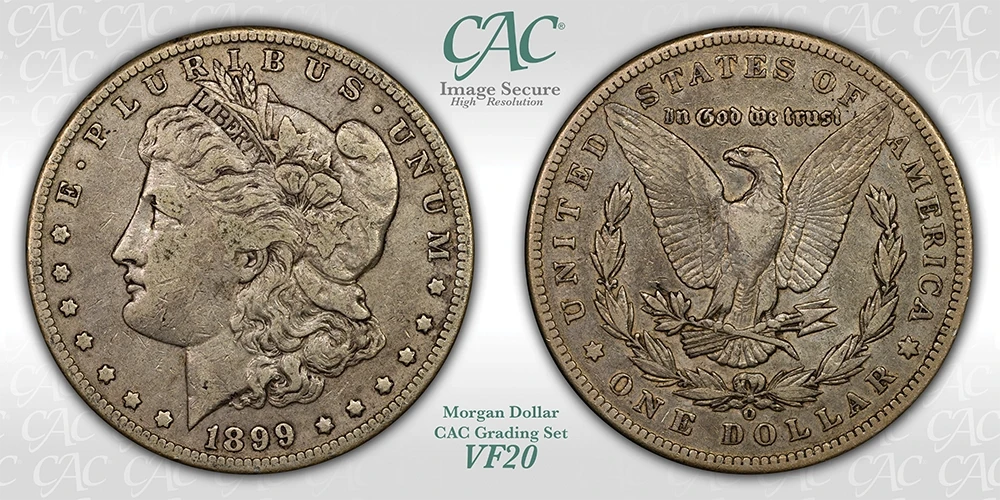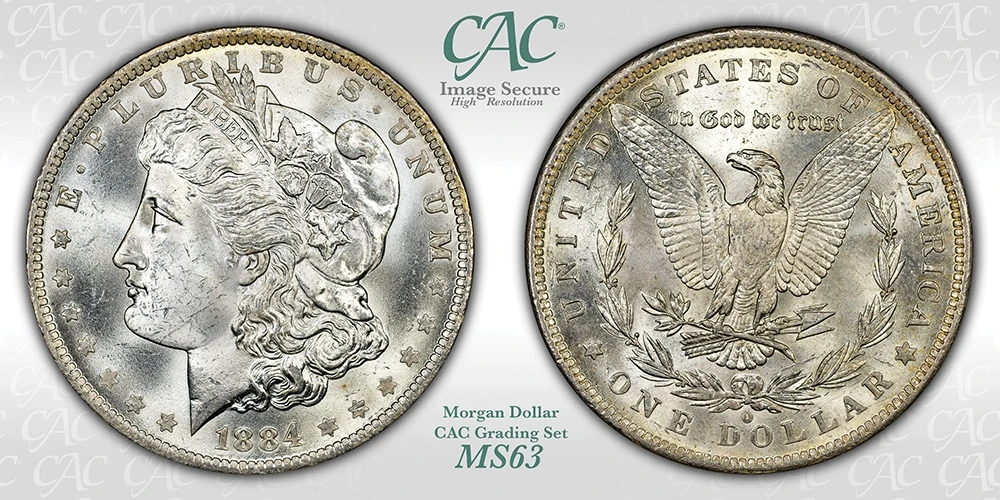
SECRETS OF THE CAC GRADING SYSTEM
In order for a coin to be certified, it has to be both authenticated and graded. Certification by a grading service is a two-step process. First step: The coin has to be determined to be genuine and unaltered. Second step: The coin has to be graded or rated on a scale of one through 70, where one is the lowest and 70 is nearly perfect.
Fake and altered or doctored coins were a major coin-market danger in the late 1970s and early 1980s before the advent of third-party grading services. Grading services were designed to assist consumers in differentiating between high-quality coins, where the difference in value between one coin with a small scratch and its counterpart without a scratch could have a multi-thousand-dollar value differential.
But, as it turned out, since grading services guaranteed that the coins they graded were genuine, these services had the effect of basically ridding the coin hobby of fake coins. After all, not only does a grading service have to warrant that the coin it’s certifying is genuine, but it has to make that determination definitively before grading it.
AUTHENTICATION
An altered coin is a real coin that has been tampered with in some way. The uncertified coins for sale that have the greatest risk of being altered are coins with rare dates and mint marks that are in high demand.
The popular 1909-S V.D.B. Lincoln cent is one example of a rare-date coin occasionally found altered. The V.D.B. are the designer’s initials, Victor David Brenner, seen on the coin’s reverse. The “S” mint mark seen on the front, or obverse, under the date stands for San Francisco.
Alterations usually are in the form of an “S” mint mark added to a common 1909 V.D.B. Lincoln cent. Sometimes an “S” can be added to the obverse; other times it can be carved out of the field in an unused or empty area underneath the date.
Another variation of an altered 1909-S V.D.B. Lincoln cent are the initials “V.D.B.” added to the reverse. Often, these are authenticated by closely examining the “B.” If the center or mid-section of the “B” is slanted, the coin is usually genuine. But if the center or mid-section of the “B” is straight, the coin is altered.
Cast counterfeits are cast impressions of copies of real coins. So, therefore, a cast counterfeit is a copy of a copy. That’s why cast counterfeits are grainy and relatively easy to recognize.
Many cast counterfeits were made to spend in commerce and to fool local merchants, not sophisticated grading services.
Die-struck counterfeits are the most difficult counterfeits to detect. A die is a metal object engraved with a coin’s design that’s used to stamp out or strike coins. These are struck from two dies, just like genuine coins. Even some top coin experts can be challenged when it comes to identifying a die-struck counterfeit.
Authenticators learn how to identify die-struck counterfeits by examining many real coins and becoming familiar with their characteristics. These authenticators also try to familiarize themselves with the characteristics of specific die-struck counterfeits.
Leaders in the coin hobby are careful not to fully explain the characteristics of the most commonly counterfeited die-struck counterfeits because that would educate the counterfeiters on how to hone their skills and remove those identifying characteristics in the next round of manufactured fakes.
COINS are GRADED ON A SCALE OF one through 70
The definitions here refer strictly to business-strike coins, the ones manufactured by a Mint for people to spend in commerce. The coins illustrated for grading are Morgan silver dollars (1878-1921), which are large coins that make for a good teaching tool.
Mint State-70. A Mint State-70 coin must be virtually perfect, with no imperfections visible under a five-power magnifying glass.
Mint State-69. The MS-69 designation is reserved for perfection’s-threshold examples. Under five-power magnification, a tiny flaw might be visible. The MS-69 designation can be used only if the coin has full and vibrant luster and, in general, if it has all the characteristics of the MS-70, with the exceptions mentioned.
Mint State-68. A coin graded MS-68 must appear perfect under five-power magnification, with the exception of a nearly imperceptible scratch, nick or flaw that appears in a non-grade-sensitive area (e.g., the hair). Upon first glance, an MS-68 will appear to be perfect and even some experts may have trouble finding the imperfection. The MS-68, like the MS-69, may show some nearly imperceptible rim flaws.
Mint State-67. An MS-67 is a wonder coin that has luster, strike and meticulously preserved surfaces that leave the viewer in a state of euphoria.
Mint State-66. An MS-66 coin is in the same high level of preservation as its MS-65 counterpart, but possesses some unusually superior or MS-67 characteristic.
Mint State-65. MS-65 is an important benchmark grade as it is the minimum grade for a “Gem.” An MS-65 cannot have excessive nicks, scratches, marks or flaws of any kind.
Mint State-64. A cursory glance at a coin deserving this grade would indicate that a grade of MS-65 is in order. But close inspection of an MS-64 coin reveals a detracting overall characteristic, such as the lack of full Mint bloom or an excess of surface marks. An MS-64 coin can be lightly fingerprinted or can exhibit weakness of strike in important areas.
Mint State-63. An MS-63 coin will often have claims to 65, except for the presence of noticeable marks visible to the unaided eye. An MS-63 may have toning that is not universally appealing and may be nearly fully struck, but, perhaps, not 100-percent fully struck.
Mint State-62. An MS-62 coin is an above-average Mint State example. It is a coin that does not overwhelm the viewer with scratches, abrasions and other detractions. Coins in this category possess all of the characteristics of their 63 counterparts, except that they are slightly deficient in quality of surface or Mint bloom.
Mint State-61. An MS-61 coin must have no wear on its highest points. It must not have been circulated. Scratches, abrasions and other imperfections will appear on coins of this classification.
Mint State-60. An MS-60 coin must have no wear on its highest points. It must not have been circulated. The MS-60 example will fall just short of being classified as a damaged coin. Occasionally, an MS-60 will be found without that one particularly detracting flaw, but the coin will possess multiple horrendous flaws, pits and deep scratches. MS-60 is the lowest grade that a coin can be assigned and still be considered Mint State.
CIRCULATED GRADES OR COINS THAT WERE SPENT
About Uncirculated-58. An AU-58 coin must appear in Mint State at first glance. Upon close examination, light friction will be visible on the highest points. Imagine a perspiration-soaked thumb rubbing the coin and envision the aftermath.
Below AU-58, the generally recognized grading-service grades in the circulated range are as follows, from highest to lowest:
- About Uncirculated-55
- About Uncirculated-53
- About Uncirculated-50
- Extremely Fine-45
- Extremely Fine-40
- Very Fine-35
- Very Fine-30
- Very Fine-25
- Very Fine-20
- Fine-15
- Fine-12
- Very Good-10
- Very Good-8
- Good-6
- Good-4
- About Good-3
- Fair-2
- Poor-1. This is the lowest grade. A coin grading 1 is so well-worn and has passed through so many hands that it is barely identifiable as to its type.
Grading descriptions are provided by Scott A. Travers and are not CAC’s official verbiage. The photos are provided by CAC as an educational aid, but individual coins can vary
by grade.
______________________________________________________________________
CAC CAN NOW PLACE COINS IT GRADES INTO HOLDERS
CAC was formed as Certified Acceptance Corporation in 2007 by John Albanese, named “Numismatist of the Century” by COINage in 2023, along with 22 other leading members of the numismatic community. Because certified coins of the same grade can be of varying quality, CAC’s mission was to advocate for the hobbyist by establishing an extremely stringent standard of grading. As a verifier of previously certified coins from other services, CAC only recognizes coins that meet the highest standard with its green sticker placed on certain already-encapsulated coins. Out of all the encapsulated coins submitted to CAC, less than half receive the coveted CAC sticker. As a result, the CAC sticker serves as an unmistakable means of identifying premium coins for the grade.
In 2022, Albanese assembled over 150 leading members of the numismatic community with a purpose to reclaim accuracy and consistency in grading as well as being able to encapsulate the coins it grades. Thus, CAC Grading, LLC was founded.
Boasting a team of world-class graders including Ron Drzewucki and John Butler, among others, CAC is committed to applying an unparalleled level of expertise to every submitted coin. As a result, hobbyists can have total confidence in a coin certified by CAC.
Go to cacgrading.com for a list of authorized dealers.




















